Bathroom Mirror FAQ
What is a bathroom TV mirror?
It's
similar in concept to a two way mirror, but allows three times more
light to pass through. Thin
layers of material are permanently deposited on a glass substrate. Each
layer filters light at an atomic level, allowing specific wavelengths to
pass through, while the rest are reflected. The TV mirrors we sell are
engineered to allow some of the light from your TV to pass through
unimpeded, while keeping enough reflectivity to shave and put on makeup.
How do I install a TV behind the mirror?
Install a small LED TV between
the studs within your bathroom wall and then hang our mirror over the
hole, mounting it like a regular mirror with mirror clips or a
J-channel. Black off the backside with black paint or felt everywhere
except for the screen area, and use a hole punch in front of the IR
sensor.
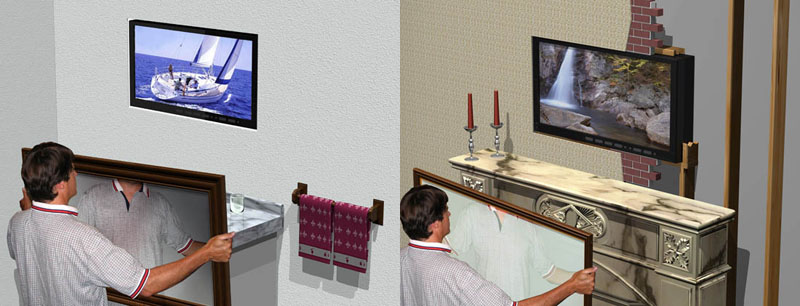
Example In-Wall LED TV Installations
|
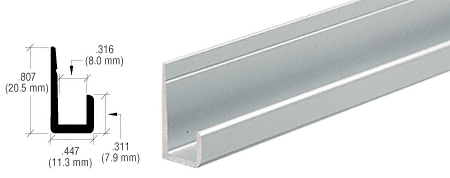
1/4" J-Channel

Mirror clips |
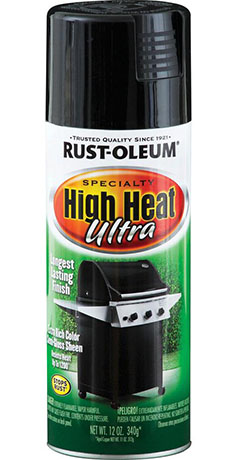
Recommended black paint |
Which side is coated?
Hold an object such as your fingernail against
the mirror. If there is a gap between the object and its
reflection, it is the uncoated side. If there is no gap between
the object and its reflection, it is the coated side.
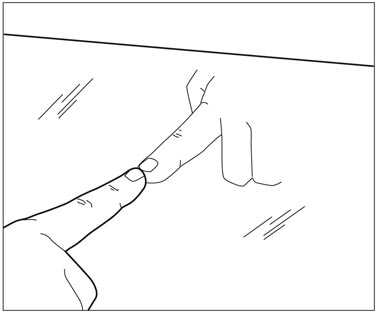
COATED SIDE - no
gap between finger and reflection |
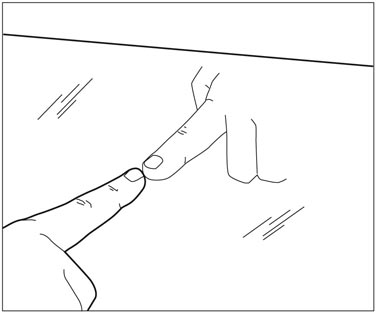
UNCOATED SIDE -
gap between finger and reflection |
Which side goes closer to the TV?
VanityVision -
Mirror coating is waterproof and should be
closer to the viewer to maximize reflectivity.
Premium ClearChrome - The mirror is equally reflective from both sides.
It is very important that the mirror is mounted with the coated
side facing the TV to protect it from scratching.
How much light passes through the mirror and how much is reflected?
VanityVision: 70% Reflective, 25% Transparent
Premium ClearChrome: 70% Reflective, 30% Transparent
What can be used to clean it?
Any standard glass cleaner such as
non-ammonia Windex works great on our mirrors,
and you can wipe it clean with regular paper towels.
Any other mirror handling tips?
To prevent chipping when resting the glass against a surface, make sure
it's carpeted, not hard. Use nitrile
gloves to maximize your grip, and for large sizes use two people and
glass suction cups to handle it.
How can I mount the mirror to the wall?
Framed: You can mount it with a frame using a z-bar hangar.
Frameless: Standard mirror clips or J-channel.
Can I tape or glue the bezel of a TV to the mirror?
You can use black silicone glue (allow several days for curing) or preferably Gunther black mirror
mastic (don't use tan color). Colors other than black will
show through. Alternatively, 3M black VHB permanent mounting tape (don't
use white or grey) works well
and is easier to work with than glue. Don't forget to mask off any unglued
or taped areas with a black material or paint for a consistent appearance.
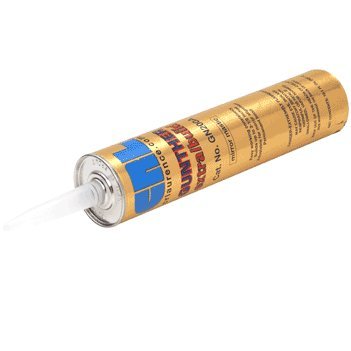
Recommended Glue |
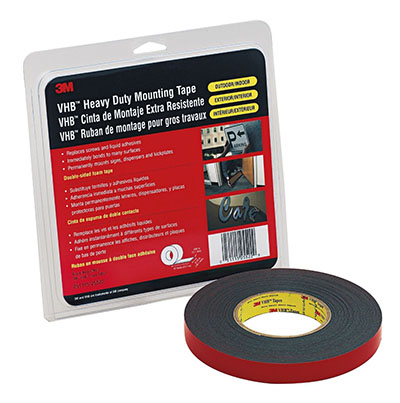
Recommended Tape |
Make sure the alignment of the TV is correct before allowing the
tape to stick to the mirror, as it is very difficult to remove. If you
make a mistake, a plastic scraper and goo-gone can be used to scrape the
tape off. Further information on how to glue a TV to glass can be found
in our
DIY frameless TV instructions.
Do you sell the frame sticks separately?
You can buy the frame sticks from us here.
What makes the VanityVision better than the Dielectric in the
bathroom?
The purpose of the Dielectric mirror is to let a maximum amount of light
while offering a mirror-like effect when off. The bathroom mirrors have
a much better reflection which allows users to shave and put on makeup
in them.
What thicknesses are available?
6mm (1/4") thickness.
The premium glass is customizable, but we generally recommend that you
use 6mm (1/4") thickness for the best balance of quality and strength.
Can the mirrors be beveled?
Yes, please contact us with the size of the mirror and we will quote
it for you.
What size should I buy?
We will cut the glass to any size you need to fit your bathroom wall.
Typcal sizes range from 30"x40" to 63"x84". You should discuss the measurements with
the contractor
doing the installation. Alternatively, you can buy a full 63"x84" stock
sheet and have it cut locally, it cuts the same as regular glass.
Choosing a TV
In-wall
installation: Almost any LED TV will work great for an in-wall bathroom
installation. Be sure to choose a TV that can lay flat against the glass
(a small number of TVs have curved bezels). Be sure that the depth of
the TV doesn't exceed the amount of space within your wall.
On-wall installation: Thinner is better, so that the mirror isn't
too
far away from the wall.
Heat dissipation
After installation, it's a good idea to put a digital thermometer in
back of the TV and leave it running for a while. Compare the maximum
heat reading to the specifications for the TV, and make sure you are not
exceeding them. If it's getting too hot, you can move it further from
the wall, or install some tiny fans in back to blow the heat upwards. When constructing the
frame or cabinet, make sure that the heat vents aren't obstructed and
that there is sufficient air flow.
Mirror size
For standard installations, the mirror should
be much bigger than the size of the TV, which is recessed into the wall.
Make the TV blend in
The back of the mirror should be covered with a thin
black material except for the part which will be
in front of the TV. The black material will help the screen blend in
when the TV is off. If you are recessing the TV into the wall, the wall
can be painted black behind the mirror. If you are using felt with a
sticky backing, do not apply the sticky side to the glass. The cloth
side should be flat against the mirror and sticky side should be
attached to a firm backing to make the felt stay flat against the glass.
Remote control
The remote control sensor can be either covered by the mirror
or you can use an infrared repeater. Infrared repeaters are an excellent
option if the sensor is going to be blocked by a picture frame or
cabinet, or to enhance the range so it can be used from a bathtub or
Jacuzzi.
Mounting
You should buy or make an in-wall mount that is
specifically designed to bring the TV flush with the wall.
Types of installations
The most popular types of installations are recessing it into the wall and building it into a cabinet. The easiest
installation is to have a frame made that is the width of the TV frame,
which holds the mirror in place over the screen. The frame is attached
to the wall around the TV.
Speakers
Use
in-wall or ceiling recessed, external speakers. Wireless speakers
are often used because you don't have to string cables.
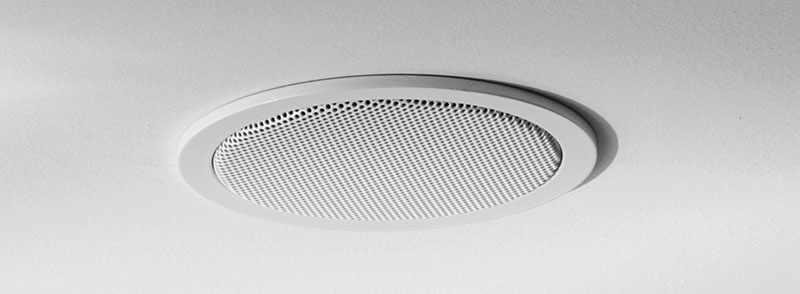
Example of Ceiling Recessed Speaker
Finding a contractor
Most of our customers work with an experienced professional to make sure
the installation goes smoothly. We recommend you consult one of the
following: cabinet makers, interior designers, carpenters, home
builders, general contractors, architects, framers, glass companies, and
other
contractors working in similar areas. We have a
dealer search to aid you in your search.
Questions?
Call us! (419) 461-0710